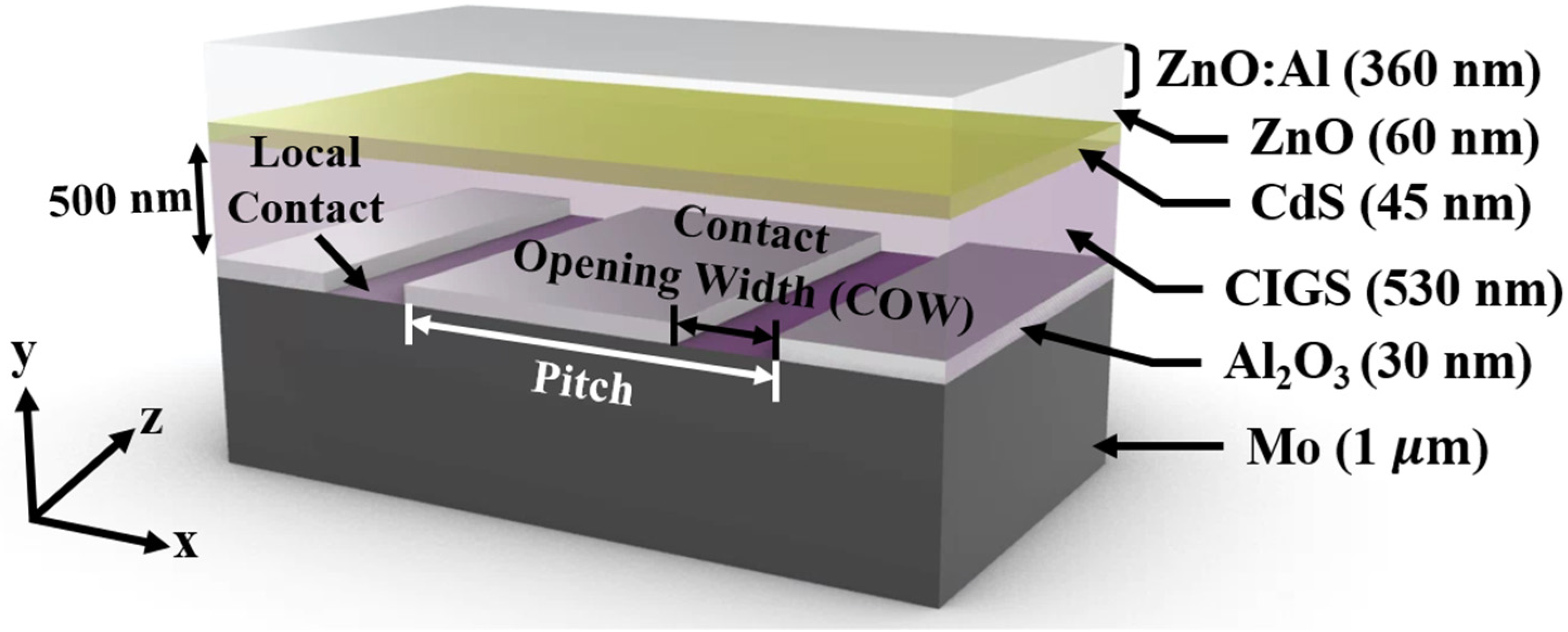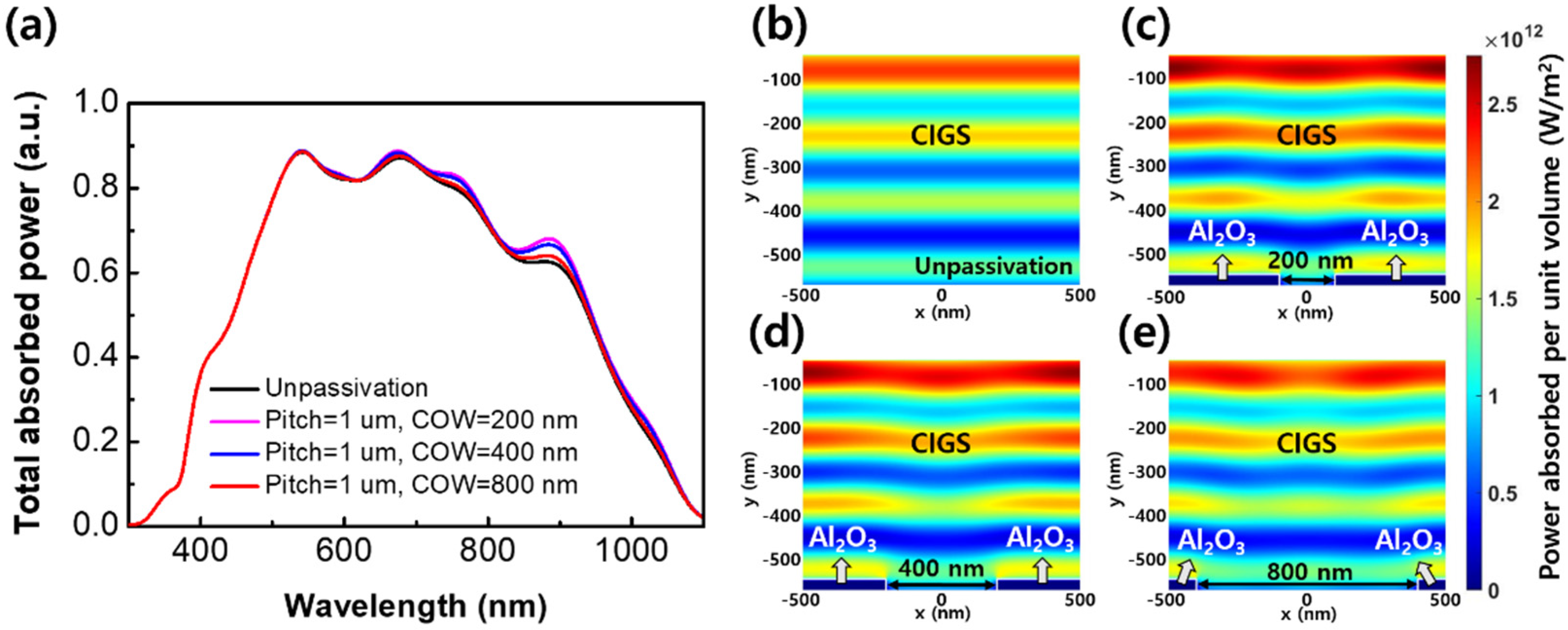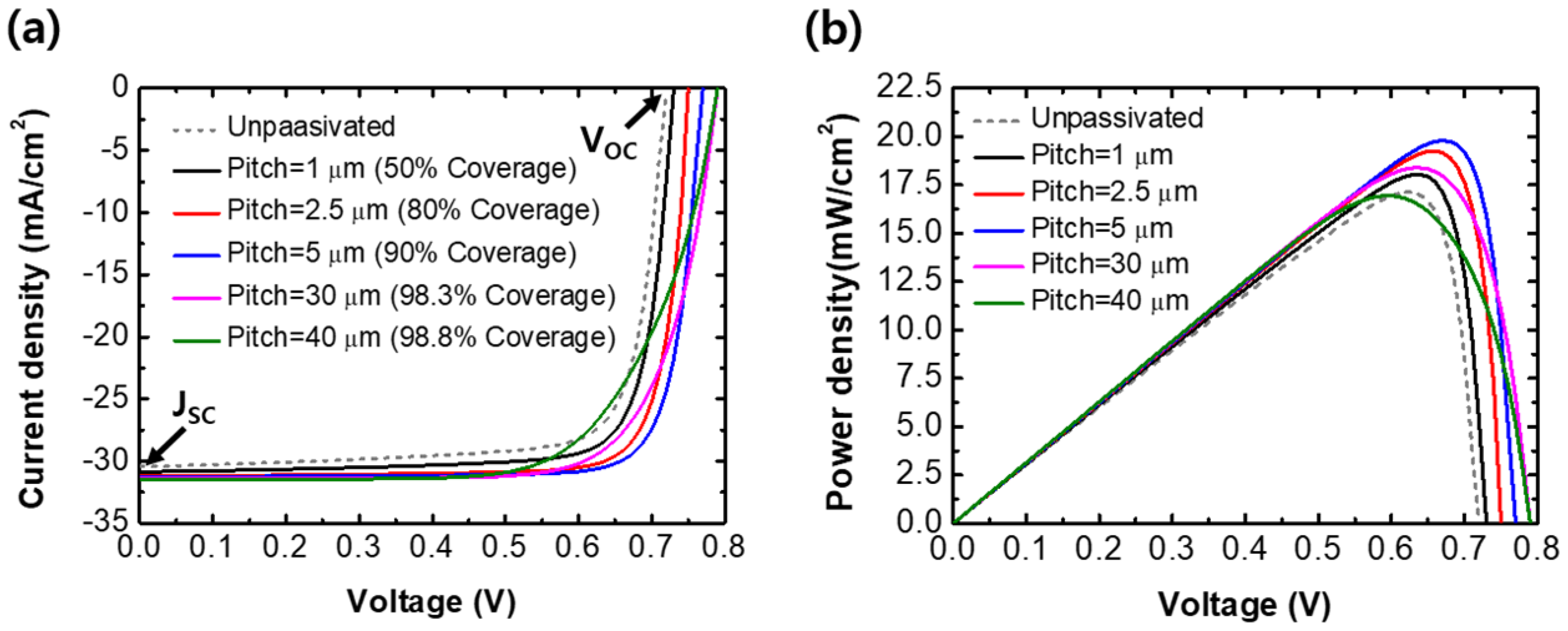Design of Grating Al2O3 Passivation Structure Optimized for High-Efficiency Cu(In,Ga)Se2 Solar Cells
Abstract
:1. Introduction
2. Designs of Optimized Thin CIGS Solar Cells with the GAPL
3. Results and Discussion
4. Conclusions
Author Contributions
Funding
Institutional Review Board Statement
Informed Consent Statement
Data Availability Statement
Conflicts of Interest
References
- Ise, F. Photovoltaics Report—Fraunhofer ISE. 2020. Available online: https://www.ise.fraunhofer.de/content/dam/ise/d (accessed on 1 November 2020).
- Mathews, I.; Kantareddy, S.N.R.; Sun, S.; Layurova, M.; Thapa, J.; Correa-Baena, J.-P.; Bhattacharyya, R.; Buonassisi, T.; Sarma, S.; Peters, I.M. Self-powered sensors enabled by wide-bandgap perovskite indoor photovoltaic cells. Adv. Funct. Mater. 2019, 29, 1904072. [Google Scholar] [CrossRef] [Green Version]
- Qiao, S.; Liu, J.; Liang, B.; Fu, G.; Li, Z.; Wang, S.; Ren, K.; Pan, C. Piezophototronic Effect Enhanced Photoresponse of the Flexible Cu(In,Ga)Se2 (CIGS) Heterojunction Photodetectors. Adv. Funct. Mater. 2018, 28, 1707311. [Google Scholar] [CrossRef]
- Chen, Q.; Zhang, Y.; Liu, S.; Han, T.; Chen, X.; Xu, Y.; Meng, Z.; Zhang, G.; Zheng, X.; Zhao, J.; et al. Switchable perovskite photovoltaic sensors for bioinspired adaptive machine vision. Adv. Intell. Syst. 2020, 2, 2000122. [Google Scholar] [CrossRef]
- Yoshikawa, K.; Kawasaki, H.; Yoshida, W.; Irie, T.; Konishi, K.; Nakano, K.; Uto, T.; Adachi, D.; Kanematsu, M.; Uzu, H.; et al. Silicon heterojunction solar cell with interdigitated back contacts for a photoconversion efficiency over 26%. Nat. Energy 2017, 2. [Google Scholar] [CrossRef]
- Kayes, B.M.; Nie, H.; Twist, R.; Spruytte, S.G.; Reinhardt, F.; Kizilyalli, I.C.; Higashi, G.S. 27.6% Conversion efficiency, a new record for single-junction solar cells under 1 sun illumination. In Proceedings of the 2011 37th IEEE Photovoltaic Specialists Conference, Seattle, WA, USA, 19–24 June 2011. [Google Scholar] [CrossRef]
- Nakamura, M.; Yamaguchi, K.; Kimoto, Y.; Yasaki, Y.; Kato, T.; Sugimoto, H. Cd-Free Cu (In,Ga)(Se, S)2 Thin-Film Solar Cell with Record Efficiency of 23.35%. IEEE J. Photovolt. 2019, 9, 1863–1867. [Google Scholar] [CrossRef]
- Yuan, J.; Zhang, Y.; Zhou, L.; Zhang, G.; Yip, H.-L.; Lau, T.-K.; Lu, X.; Zhu, C.; Peng, H.; Johnson, P.A.; et al. Single-Junction Organic Solar Cell with over 15% Efficiency Using Fused-Ring Acceptor with Electron-Deficient Core. Joule 2019, 3, 1140–1151. [Google Scholar] [CrossRef]
- Yamaguchi, M. Radiation resistance of compound semiconductor solar cells. J. Appl. Phys. 1995, 78, 1476–1480. [Google Scholar] [CrossRef]
- Philipps, S.P.; Dimroth, F.; Bett, A.W. High-efficiency III–V multijunction solar cells. In McEvoy’s Handbook of Photovoltaics; Cyprus University of Technology: Limassol, Cyprus, 2012; pp. 417–448. [Google Scholar] [CrossRef]
- Green, M.; Dunlop, E.; Hohl-Ebinger, J.; Yoshita, M.; Kopidakis, N.; Hao, X. Solar cell efficiency tables (version 57). Prog. Photovolt. Res. Appl. 2021, 29, 3–15. [Google Scholar] [CrossRef]
- Arimochi, M.; Watanabe, T.; Yoshida, H.; Tange, T.; Nomachi, I.; Ikeda, M.; Dai, P.; He, W.; Ji, L.; Lu, S.; et al. III–V compound semiconductor multi-junction solar cells fabricated by room- Temperature wafer-bonding technique. Jpn. J. Appl. Phys. 2015, 54. [Google Scholar] [CrossRef]
- Kazmerski, L.L.; Hallerdt, M.; Ireland, P.J.; Mickelsen, R.A.; Chen, W.S. Optical properties and grain boundary effects in CuInSe 2. J. Vac. Sci. Technol. A Vac. Surfaces Film. 1983, 1, 395–398. [Google Scholar] [CrossRef]
- Ullal, H.S.; Zweibel, K.; von Roedern, B. Current status of polycrystalline thin-film PV technologies. In Proceedings of the Conference Record of the Twenty Sixth IEEE Photovoltaic Specialists Conference, Anaheim, CA, USA, 29 September–3 October 1997; pp. 301–305. [Google Scholar] [CrossRef] [Green Version]
- Reinhard, P.; Chirilǎ, A.; Blösch, P.; Pianezzi, F.; Nishiwaki, S.; Buechelers, S.; Tiwari, A.N. Review of progress toward 20% efficiency flexible CIGS solar cells and manufacturing issues of solar modules. In Proceedings of the IEEE 38th Photovoltaic Specialists Conference (PVSC) PART 2, Austin, TX, USA, 3–8 June 2012. [Google Scholar] [CrossRef]
- Huang, C.H. Effects of Ga content on Cu(In,Ga)Se2 solar cells studied by numerical modeling. J. Phys. Chem. Solids 2008, 69, 330–334. [Google Scholar] [CrossRef]
- Gloeckler, M.; Sites, J.R. Band-gap grading in Cu(In,Ga)Se2 solar cells. J. Phys. Chem. Solids 2005, 66, 1891–1894. [Google Scholar] [CrossRef]
- Repins, I.; Contreras, M.; Romero, M.; Yan, Y.; Metzger, W.; Li, J.; Johnston, S.; Egaas, B.; DeHart, C.; Scharf, J.; et al. Characterization of 19.9%-Efficient CIGS Absorbers. In Proceedings of the 33rd Photovoltaic Specialists Conference, San Diego, CA, USA, 11–16 May 2008. [Google Scholar] [CrossRef] [Green Version]
- Guillemoles, J.-F.; Kronik, L.; Cahen, D.; Rau, U.; Jasenek, A.; Schock, H.-W. Stability issues of Cu(In,Ga)Se2-based solar cells. J. Phys. Chem. B 2000, 104, 4849–4862. [Google Scholar] [CrossRef]
- Jasenek, A.; Rau, U. Defect generation of Cu(In,Ga)Se2 heterojunction solar cells by high-energy electron and proton irradiation. J. Appl. Phys. 2001, 90, 650–658. [Google Scholar] [CrossRef]
- Böhnke, T.; Edoff, M.; Stenmark, L. Development of a MOEMS sun sensor for space applications. Sens. Actuators A Phys. 2006, 130–131, 28–36. [Google Scholar] [CrossRef]
- Jehl, Z.; Erfurth, F.; Naghavi, N.; Lombez, L.; Gerard, I.; Bouttemy, M.; Tran-Van, P.; Etcheberry, A.; Voorwinden, G.; Dimmler, B.; et al. Thinning of CIGS solar cells: Part II: Cell characterizations. Thin Solid Film. 2011, 519, 7212–7215. [Google Scholar] [CrossRef]
- Ko, B.S.; Sung, S.J.; Kim, D.H.; Lee, D.H.; Hwang, D.K. Effects of annealing on structural and electrical properties of sub-micron thick CIGS films. Curr. Appl. Phys. 2013, 13, S135–S139. [Google Scholar] [CrossRef]
- Vermang, B.; Fjällström, V.; Pettersson, J.; Salomé, P.; Edoff, M. Development of rear surface passivated Cu(In,Ga)Se2 thin film solar cells with nano-sized local rear point contacts. Sol. Energy Mater. Sol. Cells 2013, 117, 505–511. [Google Scholar] [CrossRef]
- Vermang, B.; Fjallström, V.; Gao, X.; Edoff, M. Improved rear surface passivation of Cu(In,Ga)Se2 solar cells: A combination of an Al2O3 rear surface passivation layer and nanosized local rear point contacts. IEEE J. Photovolt. 2014, 4, 486–492. [Google Scholar] [CrossRef]
- Choi, S.; Kamikawa, Y.; Nishinaga, J.; Yamada, A.; Shibata, H.; Niki, S. Lithographic fabrication of point contact with Al2O3 rear-surface-passivated and ultra-thin Cu(In,Ga)Se2 solar cells. Thin Solid Film. 2018, 665, 91–95. [Google Scholar] [CrossRef]
- Vermang, B.; Goverde, H.; Tous, L.; Lorenz, A.; Choulat, P.; Horzel, J.; John, J.; Poortmans, J.; Mertens, R. Approach for Al2O3 rear surface passivation of industrial p-type Si PERC above 19%. Prog. Photovolt. Res. Appl. 2012, 20, 269–273. [Google Scholar] [CrossRef]
- Bose, S.; Cunha, J.M.V.; Suresh, S.; De Wild, J.; Lopes, T.S.; Barbosa, J.R.S.; Silva, R.; Borme, J.; Fernandes, P.A.; Vermang, B.; et al. Optical Lithography Patterning of SiO2 Layers for Interface Passivation of Thin Film Solar Cells. Sol. RRL 2018, 2, 1–6. [Google Scholar] [CrossRef]
- Poncelet, O.; Kotipalli, R.; Vermang, B.; Macleod, A.; Francis, L.A.; Flandre, D. Optimisation of rear reflectance in ultra-thin CIGS solar cells towards 20% efficiency. Sol. Energy 2017, 146, 443–452. [Google Scholar] [CrossRef] [Green Version]
- Birant, G.; de Wild, J.; Meuris, M.; Poortmans, J.; Vermang, B. Dielectric-based rear surface passivation approaches for Cu(In,Ga)Se2 solar cells—A review. Appl. Sci. 2019, 9, 677. [Google Scholar] [CrossRef] [Green Version]
- Hsu, W.-W.; Chen, J.Y.; Cheng, T.-H.; Lu, S.C.; Ho, W.-S.; Chen, Y.-Y.; Chien, Y.-J.; Liu, C.W. Surface passivation of Cu(In,Ga)Se2 using atomic layer deposited Al2O3. Appl. Phys. Lett. 2012, 100, 023508. [Google Scholar] [CrossRef]
- Scheer, R.; Messmann-Vera, L.; Klenk, R.; Schock, H.-W. On the role of non-doped ZnO in CIGSe solar cells. Prog. Photovolt. Res. Appl. 2012, 20, 619–624. [Google Scholar] [CrossRef]
- Mollica, F. Optimization of Ultra-Thin Cu (In,Ga) Se2 Based Solar Cells with Alternative Back-Contacts. Ph.D. Thesis, Université Pierre et Marie Curie, Paris, France, June 2017. [Google Scholar]
- Berge, S.; Gartland, P.O.; Slagsvold, B.J. Photoelectric work function of a molybdenum single crystal for the (100), (110), (111), (112), (114), and (332) faces. Surf. Sci. 1974, 43, 275–292. [Google Scholar] [CrossRef]
- Robertson , J. High dielectric constant oxides. Eur. Phys. J. Appl. Phys. 2004, 28, 265–291. [Google Scholar] [CrossRef] [Green Version]
- Malitson, I.H. Refraction and Dispersion of Synthetic Sapphire. J. Opt. Soc. Am. 1962, 52, 1377. [Google Scholar] [CrossRef]
- Rincón, C.; Márquez, R. Defect physics of the CuInSe2 chalcopyrite semiconductor. J. Phys. Chem. Solids 1999, 60, 1865–1873. [Google Scholar] [CrossRef]
- Heo, Y.W.; Ivill, M.P.; Ip, K.; Pearton, S.J.; Chisholm, M.F.; Steiner, T. ZnO: Growth, doping and processing. Mater. Today 2004, 7, 34–40. [Google Scholar] [CrossRef]
- Kikuchi, S.; Takahashi, Y.; Sakata, T. Measurement on Work Function of Polycrystalline Zinc Oxide Covered by Organic Dye. Appl. Opt. 1969, 8, 42. [Google Scholar] [CrossRef] [PubMed]
- Romanyuk, V.; Dmitruk, N.; Karpyna, V.; Lashkarev, G.; Popovych, V.; Dranchuk, M.; Pietruszka, R.; Godlewski, M.; Dovbeshko, G.; Timofeeva, I.; et al. Optical and Electrical Properties of Highly Doped ZnO: Al Films Deposited by Atomic Layer Deposition on Si Substrates in Visible and Near Infrared Region. Acta Phys. Pol. A 2016, 129, A-36–A-40. [Google Scholar] [CrossRef]
- Lunt, R.R.; Osedach, T.P.; Brown, P.R.; Rowehl, J.A.; Bulović, V. Practical roadmap and limits to nanostructured photovoltaics. Adv. Mater. 2011, 23, 5712–5727. [Google Scholar] [CrossRef] [PubMed] [Green Version]






Publisher’s Note: MDPI stays neutral with regard to jurisdictional claims in published maps and institutional affiliations. |
© 2021 by the authors. Licensee MDPI, Basel, Switzerland. This article is an open access article distributed under the terms and conditions of the Creative Commons Attribution (CC BY) license (https://creativecommons.org/licenses/by/4.0/).
Share and Cite
Park, C.H.; Kim, J.Y.; Sung, S.-J.; Kim, D.-H.; Do, Y.S. Design of Grating Al2O3 Passivation Structure Optimized for High-Efficiency Cu(In,Ga)Se2 Solar Cells. Sensors 2021, 21, 4849. https://doi.org/10.3390/s21144849
Park CH, Kim JY, Sung S-J, Kim D-H, Do YS. Design of Grating Al2O3 Passivation Structure Optimized for High-Efficiency Cu(In,Ga)Se2 Solar Cells. Sensors. 2021; 21(14):4849. https://doi.org/10.3390/s21144849
Chicago/Turabian StylePark, Chan Hyeon, Jun Yong Kim, Shi-Joon Sung, Dae-Hwan Kim, and Yun Seon Do. 2021. "Design of Grating Al2O3 Passivation Structure Optimized for High-Efficiency Cu(In,Ga)Se2 Solar Cells" Sensors 21, no. 14: 4849. https://doi.org/10.3390/s21144849
APA StylePark, C. H., Kim, J. Y., Sung, S.-J., Kim, D.-H., & Do, Y. S. (2021). Design of Grating Al2O3 Passivation Structure Optimized for High-Efficiency Cu(In,Ga)Se2 Solar Cells. Sensors, 21(14), 4849. https://doi.org/10.3390/s21144849






